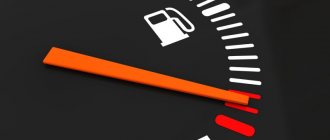The small car "Oka", developed in 1988 at VAZ, was supposed to become one of the most popular cars before the collapse of the USSR, but until 1994 it was produced in small batches, and since 1995, production was completely transferred to KamAZ and SeAZ. The peak of production began in 1998, when Oka began not only to be sold domestically, but also actively exported - due to the fall in the ruble exchange rate, its price in foreign currency turned out to be ridiculous. But the outdated design of the body and power unit did not allow the car to successfully compete with higher quality and reliable foreign analogues in the early 2000s, so its production was discontinued in 2008.
Oka 0.7
From the very beginning, a VAZ-1111 micro-displacement carburetor engine with a volume of 649 cm3 was developed for the Oka. This two-cylinder engine was capable of developing a power of 30 hp. and reach a torque of 45 Nm. The engine was paired with a 4-speed manual transmission.
Oka fuel consumption rate is 0.7 l per 100 km
- Maxim, Ufa. I have an Oka VAZ-1111, manufactured in 1994. Despite its unpresentable appearance, the car is not bad and suits me 100%. For its weight, the engine power is quite enough. By the way, consumption in the city is quite normal - 5-7 liters, but on the highway, if you drive too hard, sometimes it can reach 10 liters.
- Timur, Ryazan. I took it literally for a couple of years - it was stupid to learn how to drive. Even if I knock or break it, I don’t mind at all. However, everything turned out to be not as sad as I thought. It drives and that’s the main thing, although it doesn’t even smell like comfort. The average consumption is 6 liters – which is a lot for the tiny volume under the hood.
- Georgy, Tambov. Oka is my first car. I got it from my dad, and before that it had been sitting in the garage for five years and was rusting. Of the advantages, I will only note its unpretentiousness and the fact that it is the same Lada, only neutered and trimmed down. Gasoline consumption with a normally adjusted carburetor is 6 liters in the city, more on the highway, because the gearbox is 4-speed and at more than 90 km/h it eats gasoline like a cow.
- Irina, Rostov. When I decided to learn to drive a car, I went to a driving school, after which my father finally entrusted me with his car - a 1992 Oka. At that time, for me it was just something - but now I understand that the car was an outright log and not worth a good word. It broke down constantly, the consumption in the city was no less than 6 liters, I now have this consumption on my Hyundai with an engine 2.5 times more and 3 times more powerful.
- Sergey, Moscow. At one time, I rode a 1993 Oka for about a year and a half. This was in 2008 - I needed wheels, but there was no money, so I took an Oka, which at that time cost me about $300 - just ridiculous money. I’ll tell you that in fact everything is not as bad as it seems - if we put aside emotions, demands for comfort and all that, then this car fulfills its main purpose of transporting you from point A to point B 100%, and nothing more. need to. Consumption in the city is on average 6.5 liters, and it is generally undemanding when it comes to the quality of gasoline.
Other cars: VAZ 21124 fuel consumption reviews
Tuning the Oka engine
Since the power of the power unit is small, tuning as such does not make much sense: you can achieve an increase of up to 10%, especially with flashing the ECU of the injection version of the engine, but against the general background it will not be noticeable. The technical characteristics of Oka engines do not allow them to extract much power.
As a “custom project”, the owners of these cars can install an injector from a VAZ-21083i engine with improved characteristics, but this is a rather labor-intensive and financially expensive operation. In terms of cost, it is approximately equivalent to installing the Chinese TJ376QE mentioned above. To continue tuning and extract more power, a compressor can be installed on an injection engine and other modifications can be made as desired.
Source
Oka 0.8
In 1995, on the basis of the fairly successful VAZ-21083 engine, a stripped-down two-cylinder version of the VAZ-1113 was developed, which was equipped with the Oka car. This 750 cm3 carburetor engine developed a power of 35 hp, and the engine torque was 52 Nm. The engine was paired with a 4-speed manual transmission.
Real reviews about Oka fuel consumption 0.8 l per 100 km
- Andrey, Vladimir. I have a 2002 Oka with a 0.75 liter engine. For the money, the car is not bad, but when compared with others, it loses to everyone. There are simply zero amenities in the cabin, it constantly breaks down, although spare parts are very cheap and cost pennies. Over the course of a couple of years, I replaced four bumpers – repairing them is not an option at all, only replacing them. Consumption in the city is 7.5 liters - I’m surprised, I thought it would be much less.
- Evgeniy, Kursk. The car was made in 1997, naturally I took it second-hand, with a mileage of more than 60 thousand km. At the same time, the car stood in the garage for almost 6 years - naturally, I had to change all the gaskets, rubber bands, etc., and fill in technical fluids. The problem was with the wiring - it kept melting. Nevertheless, it is quite unpretentious and easy to maintain, but the consumption is high, as for a 0.75 liter engine - approximately 7-7.5 liters in the city, 6.5 liters on the highway.
- Kirill, Ufa. Considering that the engine in my Oka is half of the figure-eight engine that is installed on the VAZ-21083, I can’t understand why it consumes so much gasoline. The actual consumption is within 7 liters, my friend has a VAZ-21083, so that one consumes 8-9 maximum.
- Dmitry, St. Petersburg. The main advantage of Oka is its compact dimensions. It looks like there's no room, but there's actually plenty of space, especially for the driver and front passenger. Of course not at the back, but that's not a problem. Plus you can park wherever you want - for St. Petersburg this issue is acute. Consumption in the city is about 7-8 liters, but it pulls surprisingly well, you can even overtake.
- Vladimir, Orel. I owned the VAZ-1113 Oka for almost 4 years. At the time of purchase, the mileage was 45,000 km, the car was owned by a retired grandfather, who drove it once every five years. The advantage of the car is its size and the 0.75 liter engine, which is high-torque for its volume. Everything else needs to be improved - the steering, suspension and so on have been redone. Well, the weak metal of the body began to rot very quickly, even though I cooked it.
Other cars: VAZ 2115 fuel consumption reviews
Fuel consumption VAZ Oka
Rated fuel consumption is one of the most informative and important characteristics of a car for the driver. This is what manufacturers often use to advertise and promote a particular new car model.
Among owners of used cars, it is considered acceptable to consume up to 10 liters of gasoline or diesel per 100 kilometers. In foreign countries, this indicator is indicated in miles, so recalculation into “native” units is often necessary. The fuel consumption tables available in this section of the site are considered very useful.
What does the fuel consumption indicator indicate? What does this characteristic mean? We are talking about hydrocarbon fuel consumption. For example, for an SUV the figure corresponds to 9.5 liters per 100 km. It is quite acceptable, primarily due to the weight and power of the car. The indicator can be reduced due to the following:
- use of energy recovery systems during braking;
- lightening the weight of the car when replacing body and chassis elements with innovative materials;
- engine improvements;
- replacing the exhaust system.
For new models, consumption of 6 l/100 km is considered quite a “cruising” figure, but it will be higher for heavy SUVs and pickups and lower for small hybrids. The necessary information can be found in the tables provided.
What to do if fuel consumption is higher than rated? If the car consumes more fuel and does not correspond to the nominal value indicated in the table, this means there is a malfunction. Experienced service center technicians will tell you how serious it is and how it can be eliminated. In some cases, tuning makes it possible to further optimize fuel consumption, but this is usually achieved by lightening the body structure or by replacing the engine. Professional automotive technicians can provide specific recommendations.
Fuel consumption of the Lada 1111 Oka ranges from 4.7 to 6.8 liters per 100 km.
Lada 1111 Oka is available with the following types of fuel: Gasoline AI-92.
Source
Oka 1.0
The latest versions of the Oka, produced at SeAZ since 2006, received a Chinese three-cylinder small engine with a volume of 1000 cm3, which was also installed on the Daihatsu Charade G10. This engine was significantly superior in its characteristics to VAZ units - its power reached 53 hp and torque - 77 Nm. In addition, a more modern 5-speed manual transmission was offered for this engine.
Real fuel consumption Oka 1.0 l
- Yuri, Kaluga. I bought Oka for one simple reason - money, or rather, the lack of it. Actually, I have a GAZ-3110, but this car is too power hungry and not suitable for every day. But the Oka, especially with an imported engine, has low consumption, about 6.5 liters in the city and 5 liters on the highway - the Volga has two to two and a half times more. That’s why I ride the Oka all over the city, and if I go somewhere with my family, it’s on the Volga.
- Alexander, Kirov. I've had Oka for over 10 years. I have driven more than 200 thousand km. During this time, I made a capital overhaul of the engine - at 150 thousand km it stupidly caught a wedge, I had to completely overhaul it. By the way, after the capitalization the engine began to work perfectly simply - consumption dropped to 6 liters on average, sometimes even less, it pulls amazingly with such a volume. Plus I did the steering properly and slightly modified the suspension.
- Vasily, Samara. My Oka is a car for every day. I don’t care that the car is not prestigious - the main thing is that it drives and at the same time consumes a minimum of gasoline. I pump out 20-30 liters per day, covering 350-400 km. And it’s very cheap and easy to repair; it can be done by any auto mechanic whose hands grow where they need to.
- Dmitry, Simferopol. Through a friend, purely by chance, I became the owner of an Oka with a Chinese 1.0 liter engine. I bought it solely because of the price - they offered it to me for 400 bucks, a “penny” costs an order of magnitude more. The car is nothing at all - the interior completely sucks, there is no space at all, the engine has a thousand cubic meters, but in the city it consumes at least 7 liters of gasoline.
- Alexey, Moscow. My father-in-law gave me the car so I could learn to drive. He bought himself a Priora, and I didn’t have much money, so for me any option was normal. Over the course of 2 years, I certainly killed her in the trash, but I didn’t feel sorry for her. What was pleasing was the consumption of 6 liters, and sometimes even less.
Other cars: VAZ 21099 fuel consumption
Carburetor repair at Oka
The concept of carburetor repair includes the following:
- proper dismantling of the device;
- washing;
- defects;
- device diagnostics;
- OKI carburetor adjustment;
- replacement of defective parts as necessary;
- reassembly and its installation in place.
The car owner must understand the following - if he does not have any experience in vehicle maintenance, then adjusting the OKI carburetor with his own hands is impractical. For VAZ-OKA cars, carburetor repairs must be performed only in a car repair shop.
Before reading further, I recommend that you watch the video, in it you will see a lot of useful information on repairing, cleaning and adjusting the DAAZ 1111 carburetor:
The main defects that occur during carburetor operation
The carburetor is designed in such a way that exhaust gases are removed not simultaneously, but over time. In other words, the engine will experience certain difficulties when operating at high speeds. In addition, the design of the DAAZ 1111 carburetor allows lubricants from the engine to enter the carburetor. And this is a direct path to the formation of soot.
During normal operation of the ignition system, the carburetor of this model may experience the following problems:
- Unstable operation of the power plant due to the fact that carbon deposits have formed on the jets;
- Due to incorrect operation of the gas pedal, the air jets became clogged;
- A decrease in the dynamic parameters of the car, which occurs due to a decrease in the fuel level in the carburetor float chamber. That is, the engine ceases to receive the required amount of fuel to operate at high speeds;
- Uneven movement of the vehicle (jerky) indicates that carbon deposits have accumulated on the float mechanism, preventing the normal movement of fuel in the system;
- Floating engine speeds, with a constant fuel supply, indicate that there is a need to regulate the carburetor starting device.
But the main sign of malfunction of the OKA carburetor - VAZ 11113 is a sharp increase in fuel consumption.
If these defects are detected, one thing can be said - adjusting the OKA carburetor with your own hands is inevitable, and if this does not help, then it will have to be repaired in a specialized workshop where the necessary devices, fixtures and tools are available.
Removing the carburetor on the oka
Removing the carburetor from the engine is not that difficult. But you still need to adhere to a certain sequence of actions. To perform dismantling, you will need keys with jaw sizes 8 and 13, and a flat-head screwdriver.
Removing the carburetor on the oka
The sequence of operations that must be performed to dismantle the carburetor:
- Removing the air filter. Unfortunately, the carburetor is installed in such a way that it blocks access to the carburetor.
- After removing the filter, it is necessary to unscrew the bolt with which the damper is connected to the bracket and release the drive rod from all connections.
- After releasing the draft, it is necessary to disconnect the ventilation hose connected to the fitting and disconnect the wiring leading to the economizer valve.
- The next step is to disconnect the vacuum regulator hose.
- By loosening the clamp on the fuel line, you can remove the hose. In this case, you need to be prepared for the fact that a small amount of fuel may spill.
- After the carburetor is completely freed from the rods and sleeves, you can begin to dismantle it.
Immediately after the carburetor is removed from the power plant housing, a hole will be visible in it that needs to be covered. This is necessary to prevent dust and dirt from getting inside. Only then can the carburetor be adjusted.
High gas consumption in winter, what's the matter?
08.12.11 21:59
oka275
As winter sets in, questions like these keep popping up. When asked to clarify the nature of the use of the car, they answer: “Periodic trips with breaks of an hour and a half.” Therein lies the answer to the question. But is it really possible that frequent warm-ups can increase fuel consumption so much?
On the Internet I came across a thread on the Smallcar forum, where a participant under the nickname “wowanas” made some measurements. I will quote this text in full:
“In order to find out exactly how gasoline is consumed (in the urban cycle, in winter), a control measurement was carried out. Winter consumption of 10 liters per 100 km in winter seemed unrealistically high for OKI. Initial data: Car in the garage, frozen, -15 overboard. (mileage 10 thousand level, jets, ignition, rechecked many times). I hang a plastic bottle of 0.5 liter gasoline from the gas pump. (I make the first mark with a marker on the bottle.) Test progress: I start it, drive it out of the garage, heat it up for 3 minutes at 1500 rpm. (I make the second mark with a marker on the bottle). Despite the fact that the car has practically not warmed up, I drive out onto a lightly populated city road and drive 2 km in 2nd gear (the air damper is recessed), with a speed of 2300. Then I drive another 3 km in 3rd and 4th gears at a speed of 55 km/h I stop, a 0.5 liter bottle. almost empty. I take risks. Test results: on suction, as much as 0.2 liters were consumed in 3.5 minutes! (I usually heat it for about 5 minutes). For 5 km of travel in an unheated car with a cold transmission, it took 0.3 liters. Freezing at idle. (970 rpm), at temperatures from 70 to 90, amounted to 0.8 liters per hour. Conclusions: Yes, indeed, 10 liters per 100 km. BUT! If you do not take into account warming up, then 6.6 liters per 100 km. What the manufacturer promises. But I warm it up longer because -15 is very “warm”. And I move around the city in specific traffic jams.”…
That's how things are, dear reader! There is no free cheese and you have to pay for everything. I warmed up the car once - down with half a liter of gasoline. I stood for 1 hour at idle - another 0.8 liters into the pipe. And who came up with the idea of measuring fuel consumption in LITERS per 100 km??? After all, up to half of the fuel can be spent on warming up alone. And tell anyone that the Oka will only travel 100 km on 10 liters in winter - they will laugh. But on full-size cars, with the same operation, you will get all 15-17 liters per 100. But in comparison with Oka, for some reason this is immediately forgotten. All that remains are dissatisfied exclamations.
PS. The above test assumes a fully functional car and a tuned engine! Therefore, the influence on the result of such things as:
faulty or unregulated ignition (greatly increases fuel consumption!)
unadjusted or faulty carburetor (float chamber, jets, etc.)
faulty steering, suspension, incorrect wheel alignment (rolling resistance)
malfunction of the brake system (rolling resistance, additional fuel consumption to overcome it)
Last update (08.12.11 22:05)
Comments are allowed only to registered users
Oka 1111 and 11113 fuel consumption per 100 km
Oka is a car produced at the Russian factories VAZ, SeAZ and KamAZ. The history of its development begins back in the 1970s at the Serpukhov Automobile Plant, and the production of the Oka itself started only in 1988. Over a twenty-year production period, a total of about 700 thousand cars were produced.
Fuel consumption rate per 100 km
From the very beginning, the car was produced with a 0.7 liter engine with a power of 30 horsepower. The maximum speed that the 30-horsepower engine could reach was 120 km/h, and its fuel consumption was 6.5 liters in the city cycle and 5.5 liters on the highway.
- Sergey, Rostov. Lada (VAZ) 1111 (Oka) 0.7 MT 2005. This was my first car, now I drive the thirteenth model. The car is not bad in that it is easy to repair and has economical consumption. On average, about 6 liters are consumed per 100 km. The whole time I only cleaned the carburetor and that’s it. The car is very suitable for beginners.
- Maxim, Moscow. The car is so-so, since the Oka is designed to carry only one person, that is, just to take yourself for a ride. The quality of spare parts is at the lowest level. I had to completely go through everything in my 1993 VAZ. The only good thing is the consumption - in the city no more than 7 liters, on the highway 5.5-6 liters.
- Taras, Ufa. I took the car from my hands. Immediately after purchasing the 2000 Oka, I changed the brake pads and fuel filter. Overall, it’s a good car, especially well suited for driving around the city; there are no problems with parking. Due to the low weight on the track, the car is thrown in all directions. Fuel consumption is 6-6.5 liters.
- Georgy, Ryazan. I've been driving the 1994 Lada Oka for a long time, and I'm still happy with everything about it. Works 100 percent. The most important thing is to look after the car and change consumables. The 0.7 MT engine is peppy, especially at startup. Consumption is also excellent - only 6.5 liters in the city and 5.5 liters on the highway.
- Irina, Tambov. Lada 1111 0.7 MT 2007. The car is quite good and maneuverable. Just right for learning how to drive and what is under the hood. Consumption on average is 6 liters. The downside is that after a year and a half the car starts to fall apart no matter how you look after it. Very often the pipes from the stove break, plus every 6 months you have to weld the thresholds.
In 1995, the 0.7-liter was replaced by a new 2-cylinder engine with a volume of 0.8 liters. The power of such a unit is 33 horsepower, and the maximum speed is 130 km/h. At the same time, fuel consumption in the urban cycle is 7.4 liters, on the highway - 5 liters 11113
Real fuel consumption
- Vladimir, Peter. Lada (VAZ) 11113 (Oka) 0.8 MT 2000. The car, of course, lacks comfort, but its traction qualities are very normal. The engine runs well. Doesn't consume much oil or fuel. Per 100 km it comes out to around 6-6.5 liters. The big disadvantage of the Lada is its weak body, which does not resist corrosion well.
- Andrey, Orel. I see only advantages in my 2004 Oka. A very compact car - you can drive anywhere. The 0.8 MT engine consumes little fuel: about 7 liters in the city, 5 liters on the highway at 70 km/h. Despite such low consumption, the engine maintains good dynamics and can pull two people without any problems.
- Evgeny, Vladimir. I bought an Oka in 2007 with low mileage. The car is not bad, but now I have changed to another one. After modifying the suspension, the handling was excellent. I drove it for 4 years, after which the body began to crumble and became rather weak. The great advantage of this car is the 0.8 MT engine, it accelerates well and maintains a speed of 120 km/h on the highway. Consumption 7-7.5 liters.
- Kirill, Kursk. Lada (VAZ) 11113 (Oka) 0.8 MT 2002. Despite the many shortcomings of the car, it is still not bad. The salon, of course, without any amenities. It breaks down all the time, but repairs cost mere pennies. Bumpers burst very often. Fuel consumption is low - about 7.5 liters in the city, 5 liters on the highway.
- Dmitry, Ulyanovsk. I took the car second-hand (1997 model). It sat in the garage for a very long time. I changed all the rubber parts because they had dried out. I also had to change the wiring - it melted a lot. Now I’m driving, in principle, everything is fine so far. Gasoline consumption in the city is 7.3-7.5 liters, on the highway at 100 km/h 5.5 liters.
Information from the manufacturer
Along with 0.7 and 0.8 liter engines, the car was produced with a 1.0 liter engine. At the same time, the power of the power unit is significantly greater than the previous two - 53 hp. The maximum speed is 150 km/h, and fuel consumption in the city is 6.2 liters, on the highway - 4.5 liters.











